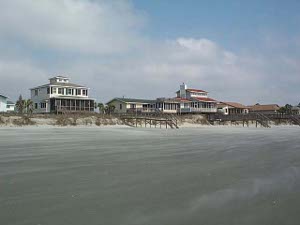There's no interstate up the coast from Savannah; not that we'd want to take it, but all the trucks and folks-in-a-hurry are driving U.S. 17, which, in places, is the only road for us slowpoke tourists. Please fix it, South Carolina!
Each of the coastal islands we explore has a different character: Hilton Head is packed with time-share golfers; Jekyll is charming and scenic; and  The Citadel
Edisto Island, which we toured on the way from Beaufort to Charleston, is a less expensive venue for those simply wanting to enjoy the beach. We didn't see a motel, and the business district was pretty tiny, and lots of the waterfront homes were available for vacation rental. The beach was wide and white.
The Citadel
Edisto Island, which we toured on the way from Beaufort to Charleston, is a less expensive venue for those simply wanting to enjoy the beach. We didn't see a motel, and the business district was pretty tiny, and lots of the waterfront homes were available for vacation rental. The beach was wide and white.
Most of these island homes are set up on stilts or pilings, to leave plenty of room for high water in the event of a hurricane.
The scenery continues to be lovely without any major surprises. We detoured from our detour down a dirt road under a canopy of Spanish-moss draped oak trees, to reach a muddy river bank where dozens of tiny crabs were doing whatever it is that tiny crabs do when they wave their one large claw in the air and menace other, tinier one-clawed crabs . . .
Perhaps it's the problem of being homeless people, but we can't seem to work up much interest in furniture stores, antique boutiques, and -- home tours. We like to walk around parks and gardens, and we're interested in exterior architecture, too, but the interiors hold less attraction for us. So Charleston, whose appeal is defined by tours of eighteenth- and nineteenth-century homes, didn't appeal to us anywhere near as much as Savannah.
 Former Navy Base
Former Navy Base
It didn't help that a cruise ship as big as a skyscraper had just discharged thousands of tourists to clog up the streets. We're spoiled, and we like to have things to ourselves. But we recovered and invented a driving tour that was interesting.
Charleston advertises its population as 80,000, but it seems a lot larger. Downtown occupies a peninsula that juts out into Charleston harbor, a protected port surrounded by islands and rivers pouring into the sea. Lots of the peninsula is still occupied by beautiful old homes, but we were somewhat astonished at the number of homes in the heart of the city that were literally falling down. Cities ought to tear down buildings when they become public dangers.
The Citadel is right in Charleston, and we drove around the parade ground, watching the cadets in gray uniforms walk between classes. The freshmen walk stiffly and square all their corners.
The former Charleston Navy Base has been BRAC - ed, and the buildings are now being put to a variety of uses, such as marine industry. There were civilian guards at all the gate houses, but they seemed to be more to help visiting truckers figure out where to go. Some of the officers' housing appeared to be occupied, and one was being used as a movie set, but the O-Club on the riverfront looked decrepit and should be torn down. The admiral's house, sitting atop the only hill on the peninsula, looked unoccupied.
 Houses at Folly Beach
Houses at Folly Beach
Of course the springtime color is wonderful, with dogwood, wisteria, azaleas along with Spanish moss dripping from oak trees.
We didn't see any young ladies in period costumes with hoop skirts and parasols, but then we didn't visit any of the local plantations, either.
The taking of Fort Sumter, on an island in Charleston Harbor, generally marks the beginning of the Civil War. Charleston was a major port of entry, and trading ships ran the Union blockade to deliver supplies to the Confederacy. Charleston also suffered more damage in the war, whereas Savannah graciously capitulated to General Sherman and avoided the burning.
We took another drive to the ocean, this time to Folly Beach, which was yet another kind of sea island, with older, less pretentious beach houses, many of which advertised their availability for vacation rental. We saw one three-story motel on the beach, and a few townhouses recently constructed. The beach was nearly empty in the morning, but judging from the signs it gets pretty crowded in summer.
Across the river from downtown Charleston we found two restaurants near a marina. California Dreamin was well advertised and the lot was full of cars; The Crab House was much less busy, but we wanted sea food. We weren't disappointed, either, with fresh local oysters and shrimp and she-crab soup. We had a window seat where we watched cormorants, a pelican and a tiny egret all get something to eat from the water.
 The Citadel
Edisto Island, which we toured on the way from Beaufort to Charleston, is a less expensive venue for those simply wanting to enjoy the beach. We didn't see a motel, and the business district was pretty tiny, and lots of the waterfront homes were available for vacation rental. The beach was wide and white.
The Citadel
Edisto Island, which we toured on the way from Beaufort to Charleston, is a less expensive venue for those simply wanting to enjoy the beach. We didn't see a motel, and the business district was pretty tiny, and lots of the waterfront homes were available for vacation rental. The beach was wide and white.
 Former Navy Base
Former Navy Base Houses at Folly Beach
Houses at Folly Beach